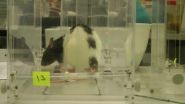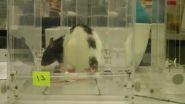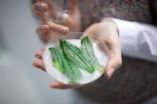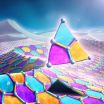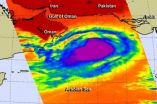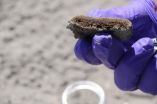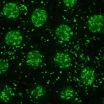(Press-News.org) VIDEO:
This video depicts Restored grasping after immunotherapy and rehabilitative training.
Click here for more information.
Only if the timing, dosage and kind of rehabilitation are right can motor functions make an almost full recovery after a large stroke. Rats that were paralyzed down one side by a stroke almost managed to regain their motor functions fully if they were given the ideal combination of rehabilitative training and substances that boosted the growth of nerve fibers. Anatomical studies confirmed the importance of the right rehabilitation schedule: Depending on the therapeutic design, different patterns of new nerve fibers that sprouted into the cervical spinal cord from the healthy part of the brain and thus aid functional recovery to varying degrees were apparent. The study conducted by an interdisciplinary team headed by Professor Martin Schwab from the Brain Research Institute at the University of Zurich and ETH Zurich's Neuroscience Center is another milestone in research on the repair of brain and spinal cord injuries.
"This new rehabilitative approach at least triggered an astonishing recovery of the motor skills in rats, which may become important for the treatment of stroke patients in the future," says first author Anna-Sophia Wahl. At present, patients have to deal with often severe motor-function, language and vision problems, and their quality of life is often heavily affected.
Allow nerves to grow first, then train
On the one hand, the treatment of rats after a stroke involves specific immune therapy, where so-called Nogo proteins are blocked with antibodies. These proteins in the tissue around the nerve fibers inhibit nerve-fiber growth. If they are blocked, nerve fibers begin to sprout in the injured sections of the brain and spinal cord and relay nerve impulses again. On the other hand, the stroke animals, whose front legs were paralyzed, underwent physical training – namely, gripping food pellets. All the rats received antibody treatment first to boost nerve-fiber growth and – either at the same time or only afterwards – motor training.
The results are surprising: The animals that began their training later regained a remarkable 85 percent of their original motor skills. For the rats that were trained straight after the stroke in parallel with the growth-enhancing antibodies, however, it was a different story: At 15 percent, their physical performance in the grip test remained very low.
Meticulous design very promising
The researchers consider timing a crucial factor for the success of the rehabilitation: An early application of growth stimulators – such as antibodies against the protein Nogo-A – triggers an increased sprouting and growth of nerve fibers. The subsequent training is essential to sift out and stabilize the key neural circuits for the recovery of the motor functions. For instance, an automatic, computer-based analysis of the anatomical data from the imaging revealed that new fibers in the spinal cord sprouted in another pattern depending on the course of treatment. By reversibly deactivating the new nerve fibers that grow, the neurobiologists were ultimately able to demonstrate for the first time that a group of these fibers is essential for the recovery of the motor function observed: Nerve fibers that grew into the spinal cord from the intact front half of the brain – changing sides – can reconnect the spinal cord circuits of the rats' paralyzed limbs to the brain, enabling the animals to grip again.
"Our study reveals how important a meticulous therapeutic design is for the most successful rehabilitation possible," sums up study head Martin Schwab. "The brain has enormous potential for the reorganization and reestablishment of its functions. With the right therapies at the right time, this can be increased in a targeted fashion."
INFORMATION:
A successful interdisciplinary approach
The study was a collaborative project between biologists, physicians and computer scientists. The interdisciplinary team headed by Professor Martin Schwab from UZH's Brain Research Institute and UZH and ETH Zurich's Neuroscience Center included Professor Fritjof Helmchen's group within the same institute and, at the University of Heidelberg, Professor Björn Ommer's group at the Heidelberg Collaboratory for Image Processsing and the Interdisciplinary Center for Scientific Computing.
Literature :
Wahl, A.S., Omlor, W., Rubio, J.C., Chen, J.L., Zheng, H., Schröter, A., Gullo, M., Weinmann, O., Kobayashi, K., Helmchen, F., Ommer, B., Schwab, M.E. Asynchronous therapy restores motor control by rewiring of the rat corticospinal tract after stroke. Science, June 13, 2014. doi: 10.1126/science.1253050
Contact:
Prof. Martin E. Schwab
Brain Research Institute
University of Zurich
Neuroscience Center Zurich of ETH and University of Zurich
Winterthurerstr. 190
8057 Zurich
Phone: +41 44 635 3330
E-mail: schwab@hifo.uzh.ch
Dr. Anna-Sophia Wahl
Brain Research Institute
University of Zurich
Neuroscience Center Zurich of ETH and University of Zurich
Winterthurerstr. 190
8057 Zurich
Phone: +41 44 635 3228
E-mail: wahl@hifo.uzh.ch
Bettina Jakob
Media Relations
University of Zurich
Tel. +41 44 634 44 39
E-mail: bettina.jakob@kommunikation.uzh.ch
INFORMATION: END
With the right rehabilitation, paralyzed rats learn to grip again
2014-06-12
ELSE PRESS RELEASES FROM THIS DATE:
Unexpected origin for important parts of the nervous system
2014-06-12
A new study from Karolinska Institutet in Sweden shows that a part of the nervous system, the parasympathetic nervous system, is formed in a way that is different from what researchers previously believed. In this study, which is published in the journal Science, a new phenomenon is investigated within the field of developmental biology, and the findings may lead to new medical treatments for congenital disorders of the nervous system.
Almost all of the body's functions are controlled by the autonomous, involuntary nervous system, for example the heart and blood vessels, ...
Scientists discover link between climate change and ocean currents over 6 million years
2014-06-12
Scientists have discovered a relationship between climate change and ocean currents over the past six million years after analysing an area of the Atlantic near the Strait of Gibraltar, according to research published today (Friday, 13 June) in the journal Science.
An expedition of scientists, jointly led by Dr Javier Hernandez-Molina, from the Department of Earth Sciences at Royal Holloway, University of London, examined core samples from the seabed off the coast of Spain and Portugal which provided proof of shifts of climate change over millions of years.
The team ...
Habitat fragmentation increases vulnerability to disease in wild plants
2014-06-12
Proximity to other meadows increases disease resistance in wild meadow plants, according to a study led by Anna-Liisa Laine at the University of Helsinki. The results of the study, analysing the epidemiological dynamics of a fungal pathogen in the archipelago of Finland, will be published in Science on 13 June 2014.
The study surveyed more than 4,000 Plantago lanceolata meadows and their infection status by a powdery mildew fungus in the Åland archipelago of Finland. The surveys have continued since 2001, resulting in one of the world's largest databases on disease dynamics ...
Quantum computation: Fragile yet error-free
2014-06-12
This news release is available in German and Spanish. Even computers are error-prone. The slightest disturbances may alter saved information and falsify the results of calculations. To overcome these problems, computers use specific routines to continuously detect and correct errors. This also holds true for a future quantum computer, which will require procedures for error correction as well: "Quantum phenomena are extremely fragile and error-prone. Errors can spread rapidly and severely disturb the computer," says Thomas Monz, member of Rainer Blatt's research group ...
Movies with gory and disgusting scenes more likely to capture and engage audience
2014-06-12
Washington, DC (June 12, 2014) – We know it too well. We are watching a horror film and the antagonist is about to maim a character; we ball up, get ready for the shot and instead of turning away, we lean forward in the chair, then flinch and cover our eyes – Jason strikes again! But what is going on in our body that drives us to this reaction, and why do we engage in it so readily? Recent research published in the Journal of Communication found that people exposed to core disgusts (blood, guts, body products) showed higher levels of attention the more disgusting the content ...
NASA takes Tropical Cyclone Nanuak's temperature
2014-06-12
Tropical Cyclone Nanauk is holding its own for now as it moves through the Arabian Sea. NASA's Aqua satellite took its cloud top temperatures to determine its health.
In terms of infrared data viewing tropical cyclones, those with the coldest cloud top temperatures indicate that a storm is the most healthy, most robust and powerful. That's because thunderstorms that have strong uplift are pushed to the top of the troposphere where temperatures are bitter cold. Infrared data, such as that collected from the Atmospheric Infrared Sounder (AIRS) instrument that flies aboard ...
Findings point toward one of first therapies for Lou Gehrig's disease
2014-06-12
CORVALLIS, Ore. – Researchers have determined that a copper compound known for decades may form the basis for a therapy for amyotrophic lateral sclerosis (ALS), or Lou Gehrig's disease.
In a new study just published in the Journal of Neuroscience, scientists from Australia, the United States (Oregon), and the United Kingdom showed in laboratory animal tests that oral intake of this compound significantly extended the lifespan and improved the locomotor function of transgenic mice that are genetically engineered to develop this debilitating and terminal disease.
In humans, ...
Scientists identify Deepwater Horizon Oil on shore even years later, after most has degraded
2014-06-12
Years after the 2010 Deepwater Horizon Oil spill, oil continues to wash ashore as oil-soaked "sand patties," persists in salt marshes abutting the Gulf of Mexico, and questions remain about how much oil has been deposited on the seafloor. Scientists from Woods Hole Oceanographic Institution and Bigelow Laboratory for Ocean Sciences have developed a unique way to fingerprint oil, even after most of it has degraded, and to assess how it changes over time. Researchers refined methods typically used to identify the source of oil spills and adapted them for application on a ...
Anti-dsDNA, surface-expressed TLR4 and endosomal TLR9 cooperate to exacerbate lupus
2014-06-12
Systemic lupus erythematosus (SLE) is a complicated multifactorial autoimmune disease influenced by many genetic and environmental factors. The hallmark of systemic lupus erythematosus (SLE) is the presence of high levels of anti-double-stranded DNA autoantibody (anti-dsDNA) in sera. In addition, greater infection rates are found in SLE patients and higher morbidity and mortality usually come from bacterial infections. Deciphering interactions between the susceptibility genes and the environmental factors for lupus complex traits is challenging and has resulted in only ...
Protein anchors help keep embryonic development 'just right'
2014-06-12
The "Goldilocks effect" in fruit fly embryos may be more intricate than previously thought. It's been known that specific proteins, called histones, must exist within a certain range—if there are too few, a fruit fly's DNA is damaged; if there are too many, the cell dies. Now research out of the University of Rochester shows that different types of histone proteins also need to exist in specific proportions. The work further shows that cellular storage facilities keep over-produced histones in reserve until they are needed.
Associate Professor of Biology Michael Welte ...
